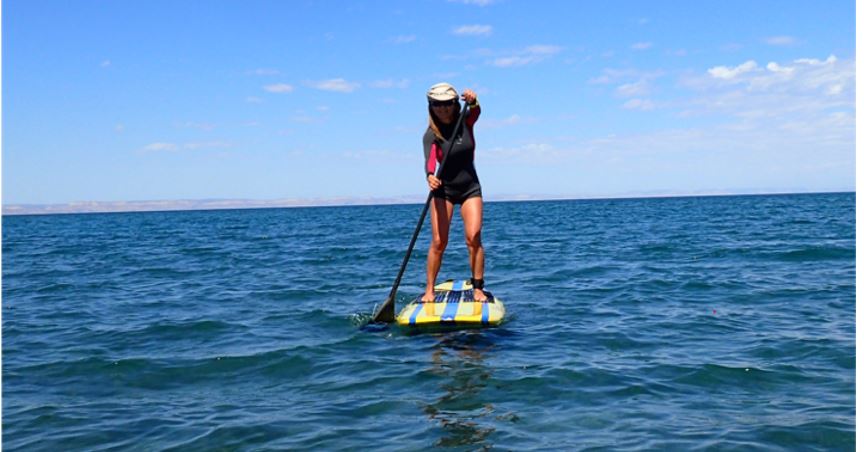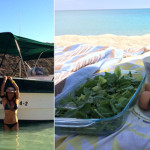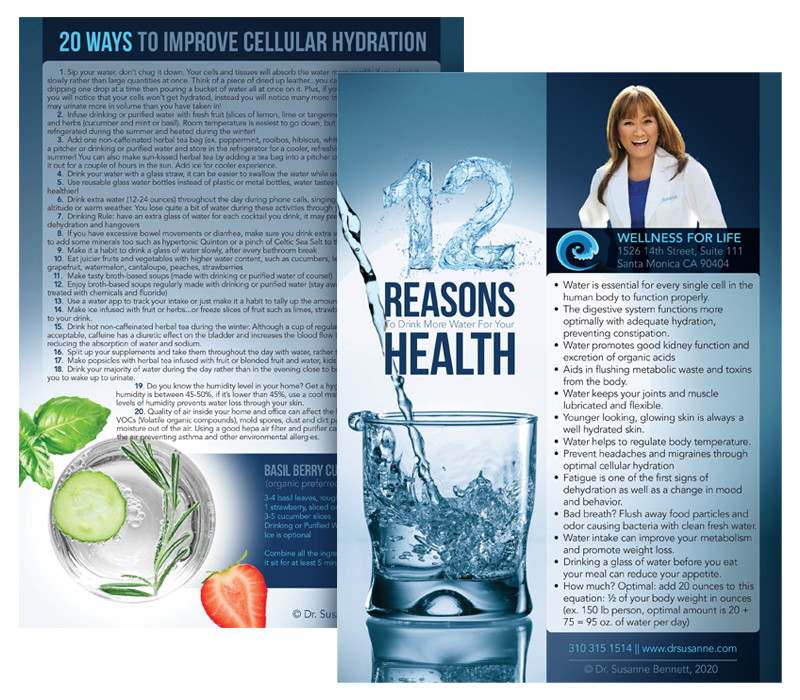With spring finally here and days are getting longer, temperatures will continue to rise with warm sunshine and clear blue skies.
So, before stepping outside, we want to be mindful about sun protection, and should apply the correct formula that protects our skin and your children’s delicate skin, particularly in the areas that a prone to sun exposure and damage, such as your face, shoulders and chest.
 Here I am all covered up under the hot La Paz sun!
Here I am all covered up under the hot La Paz sun!
With so many different brands available as well as various types of chemicals in sunscreens and sun blocks, you may feel overwhelmed and often have difficulty choosing the right type of formula or SPF.
I am going to make it easy for you and give you the details on which best sun care formulas to get and some tips and tricks in natural sun protection.
1. First let me give you some Sun Facts!
The sun emits two types of ultraviolet light that affect human skin, UVA and UVB. UVB is much stronger than UVA, and it has an immediate impact on skin, within 60 seconds.
It is most powerful during the summer and especially between the hours of 11 a.m. to 4 p.m. UVB is completely blocked by glass (windows) whereas UVA radiation penetrates through glass and windows and can cause damage to the skin even during cloudier days.
Although UVA is lower in intensity and is not felt by the skin, it is the main cause of premature skin aging (wrinkles, sagging and age spots) and possibly skin cancer.
I have to tell you that a few weeks ago when I was in Miami for a conference, I actually got a second-degree burn on my skin!
I acted quickly and healed my blisters and pain in one hour, so miraculously that I got so inspired and made a 4 part Skin Secrets miniseries that goes into detail on how to heal damaged skin from the sun and premature skin aging.
You can go to drsusanne.com/miniseries to get the free 4 part Skin Secrets miniseries!
2. What does SPF mean?
It stands for Sun Protection Factor. SPF numbers are designed to describe the length of time you can stay in the sun before you start burning your skin. For example, if you normally start to burn after 30 minutes of direct sunlight, then an SPF 30 product should let you stay in the sun for approximately 30 times longer without burning.
What is the difference between sun blocks and sunscreens? Both formulas protect our skin from sun damage by different mechanisms.
Sun blocks actually sit “on” the skin and act as a barrier to reflect away ultraviolet (UV) rays — both UVA and UVB radiation can cause sunburn and skin damage, and possibly even skin cancer.
So it “BLOCKS” the sun UV rays from penetrating into the skin and damaging the delicate tissue. Zinc Oxide and Titanium Dioxide are both sun blocking agents for both UVA and UVB rays.
Sun blocks usually start at an SPF (Sun Protection Factor) of 15 or higher. All SPF ratings apply only to UVB protection, not UVA.
In comparison, sunscreens are made with chemicals that absorb and neutralize the ultraviolet radiation.
Sunscreen chemicals typically protect against either UVA or UVB, while only a few protect against both types of radiation.
As a result, sunscreens usually have mixtures of both kinds of chemicals in order to be labeled as “broad spectrum” — and to be fully protective.
The SPF levels of sunscreens are widely varied, starting as low as 2 and rising as high as 100+.
I have big concerns about chemical sunscreens acting as endocrine disruptors — compounds that mimic hormones and activate hormone receptors. Some studies have indicated that these chemicals may generate free radicals that can damage skin and possibly cause skin cancer.
3. Go for the sun blocks rather than the sunscreens.
- I always suggest using sun blocks rather than sunscreens. Look for formulas that have either zinc oxide or titanium dioxide in them. Out of the two, zinc oxide causes fewer allergic reactions. These are natural mineral compounds that will “block” the UV rays from penetrating the skin; the only drawback I know of is that they may leave a white residue.I suggest staying away from products claiming they use “nano-particles” (between 1 to 100 nanometers), which can penetrate skin. Don’t forget to follow product warnings for infants under 6 months old.
- I believe in avoiding synthetic estrogen compounds, which appear under names such as oxybenzone (benzophenone-3 and 4-methyl-benzylidene camphor (4-MBC), as well as other derivatives that are super free radical generators (causing skin damage) such as avobenzone, Parsol 1789, dioxybenzone, ethylhexyl p-methoxycinnimate, 2-ethylhexyl salicylate, protamine salicylate, homosalate and PABA.
- Also avoid—Sunscreens with added insect repellents such as deet and permethrin, they are super toxic and can cause damage to you and your child’s nervous system.
Purchase cream-based products only. Avoid sprays and powders, as the vapors and particulates can easily be inhaled and irritate nasal passages and respiratory system. - Use an SPF of at least 15 — and apply plenty of it often.
- Before using any sunscreen or sunblock, test it by applying a small amount to your child’s wrist. If the skin turns red, itchy or irritated within 20 minutes, try another brand.
4. The best defense from damaging UV rays is prevention.
Use these common-sense Sun Safety Tips before grabbing the sunblock/sunscreens:
- Wear loose, cotton/linen, and light-colored clothes. Long sleeve shirts, pants and dresses will reduce UV rays from penetrating the skin. A good hat with a large brim will protect the face, neck, eyes and ears.
- If you are a water sports lover like I am, wear a rash guard or even full-body rash guard/swimsuit. It also works beautifully for children who love to be in the water for hours at a time. Use a hat that can be cinched down under the chin.
- Play in the shade. Use a parasol or umbrella at the beach or park, and keep infants completely out of the sun: sunscreen should not be used under six months of age due to their sensitive skin. In addition, infants under the age of 12 months do not have enough melanin, a protective pigment in skin that helps block out UV rays.
- Schedule indoor or shaded play dates around the peak sun hours 11 a.m. to 4 p.m.
- Wear polarized sunglasses to prevent skin damage around the eye and cataracts. Do attach the glasses to straps, so you don’t lose them!
- Use removable mesh window shields to keep direct sunlight from coming in through the windows of your car.
- Eat organic foods high in antioxidants to build up your “internal sunscreen”, including fresh vegetables, dark greens and fruits such as berries, pomegranate, acai and goji berries. For children who shy away from veggies, give them a daily antioxidant supplement loaded with Vitamin C, Vitamin E and greens.
We do need our daily dose of vitamin D, but on sensitive areas that are well known to grow skin cancer, such as your face, chest and shoulders, do use the best form of sunblock to prevent premature aging and sun damage and definitely to keep your healthy glowing skin!
While you’re at it, grab your hat before going out too!
BTW: Don’t for get to join me on the Glowing Skin Summit, it starts today, April 27, 2015!
https://drsusanne.com/glowingskinsummit






Any thoughts on astaxanthin taken internally as a “sunscreen”?
Hi Christy,
Absolutely- it totally works! But make sure you use a zinc oxide sunblock daily anyway so you can have double protection to prevent sun damage and premature aging skin.
Dr. Susanne